Papers by Cathleen Willging

Journal of health care for the poor and underserved, 2005
State governments throughout the country increasingly have turned to managed care for their Medic... more State governments throughout the country increasingly have turned to managed care for their Medicaid programs, including mental health services. We used ethnographic methods and a review of legal documents and state monitoring data to examine the impact of Medicaid reform on mental health services in New Mexico, a rural state. New Mexico implemented Medicaid managed care for both physical and mental health services in 1997. The reform led to administrative burdens, payment problems, and stress and high turnover among providers. Restrictions on inpatient and residential treatment exacerbated access problems for Medicaid recipients. These facts indicate that in rural, medically underserved states, the advantages of managed care for cost control, access, and quality assurance may be diminished. Responding to the crisis in mental health services, the federal government terminated New Mexico's program but later reversed its decision after political changes at the national level. This...
We assessed the role of promotoras—briefly trained community health workers—in depression care at... more We assessed the role of promotoras—briefly trained community health workers—in depression care at community health centers. The intervention focused on four contextual sources of depression in underserved, lowincome communities: underemployment, inadequate housing, food insecurity, and violence. A multi-method design included quantitative and ethnographic techniques to study predictors of depression and the intervention’s impact. After
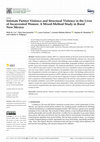
International Journal of Environmental Research and Public Health
Intimate partner violence (IPV) is a common feature in the lives of incarcerated women returning ... more Intimate partner violence (IPV) is a common feature in the lives of incarcerated women returning to rural communities, enhancing their risk of mental ill-health, substance use, and recidivism. Women’s experiences of IPV intersect with challenges across multiple social–ecological levels, including risky or criminalizing interpersonal relationships, geographic isolation, and persistent gender, racial, and economic inequities. We conducted quantitative surveys and qualitative interviews with 99 incarcerated women in New Mexico who were scheduled to return to micropolitan or non-core areas within 6 months. Quantitative and qualitative data were analyzed separately and then triangulated to identify convergences and divergences in data. The findings underscore how individual and interpersonal experiences of IPV, substance use, and psychological distress intersect with broad social inequities, such as poverty, lack of supportive resources, and reluctance to seek help due to experiences of ...

Background: Inequities exist in delivery of helpful, effective healthcare interventions. One emer... more Background: Inequities exist in delivery of helpful, effective healthcare interventions. One emerging paradigm to address these inequities is to engage consumers of healthcare (e.g., patients, families, caregivers) in the implementation process. There are not enough examples or standards of successful consumer engagement in implementation, which limits clarity on processes other implementers could be using. Implementation scientists need a clear foundation from which to build processes or strategies with more specificity to engage consumers in healthcare settings. Methods: We conducted an environmental scan of three data sources: archived webinars, literature review articles, and interviews/observations with implementers who engaged consumers in efforts to introduce new programs and practices in healthcare settings. We described examples of consumer engagement in implementation efforts, categorized recurring challenges, and identified promising solutions to those challenges. We extr...
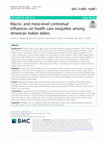
BMC Public Health
Background American Indian elders, aged 55 years and older, represent a neglected segment of the ... more Background American Indian elders, aged 55 years and older, represent a neglected segment of the United States (U.S.) health care system. This group is more likely to be uninsured and to suffer from greater morbidities, poorer health outcomes and quality of life, and lower life expectancies compared to all other aging populations in the country. Despite the U.S. government’s federal trust responsibility to meet American Indians’ health-related needs through the Indian Health Service (IHS), elders are negatively affected by provider shortages, limited availability of health care services, and gaps in insurance. This qualitative study examines the perspectives of professional stakeholders involved in planning, delivery of, and advocating for services for this population to identify and analyze macro- and meso-level factors affecting access to and use of health care and insurance among American Indian elders at the micro level. Methods Between June 2016 and March 2017, we undertook in-...
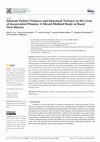
International Journal of Environmental Research and Public Health, 2021
Intimate partner violence (IPV) is a common feature in the lives of incarcerated women returning ... more Intimate partner violence (IPV) is a common feature in the lives of incarcerated women returning to rural communities, enhancing their risk of mental ill-health, substance use, and recidivism. Women’s experiences of IPV intersect with challenges across multiple social–ecological levels, including risky or criminalizing interpersonal relationships, geographic isolation, and persistent gender, racial, and economic inequities. We conducted quantitative surveys and qualitative interviews with 99 incarcerated women in New Mexico who were scheduled to return to micropolitan or non-core areas within 6 months. Quantitative and qualitative data were analyzed separately and then triangulated to identify convergences and divergences in data. The findings underscore how individual and interpersonal experiences of IPV, substance use, and psychological distress intersect with broad social inequities, such as poverty, lack of supportive resources, and reluctance to seek help due to experiences of ...
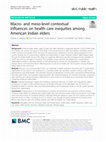
Background American Indian elders, aged 55 years and older, represent a neglected segment of the ... more Background American Indian elders, aged 55 years and older, represent a neglected segment of the United States (U.S.) health care system. This group is more likely to be uninsured and to suffer from greater morbidities, poorer health outcomes and quality of life, and lower life expectancies compared to all other aging populations in the country. Despite the U.S. government’s federal trust responsibility to meet American Indians’ health-related needs through the Indian Health Service (IHS), elders are negatively affected by provider shortages, limited availability of health care services, and gaps in insurance. This qualitative study examines the perspectives of professional stakeholders involved in planning, delivery of, and advocating for services for this population to identify and analyze macro- and meso-level factors affecting access to and use of health care and insurance among American Indian elders at the micro level. Methods Between June 2016 and March 2017, we undertook in-...

Translational Behavioral Medicine
While implementation science is driven by theory, most implementation science theories, models, a... more While implementation science is driven by theory, most implementation science theories, models, and frameworks (TMF) do not address issues of power, inequality, and reflexivity that are pivotal to achieving health equity. Theories used in anthropology address these issues effectively and could complement prevailing implementation science theories and constructs. We propose three broad areas of theory that complement and extend existing TMF in implementation science to advance health equity. First, theories of postcoloniality and reflexivity foreground attention to the role of power in knowledge production and to the ways that researchers and interventionists may perpetuate the inequalities shaping health. Second, theories of structural violence and intersectionality can help us to better understand the unequal burden of health disparities in the population, thereby encouraging researchers to think beyond single interventions to initiate partnerships that can impact overlapping healt...
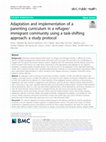
BMC Public Health
Background Delivering evidence-based interventions to refugee and immigrant families is difficult... more Background Delivering evidence-based interventions to refugee and immigrant families is difficult for several reasons, including language and cultural issues, and access and trust issues that can lead to an unwillingness to engage with the typical intervention delivery systems. Adapting both the intervention and the delivery system for evidence-based interventions can make those interventions more appropriate and palatable for the targeted population, increasing uptake and effectiveness. This study focuses on the adaptation of the SafeCare© parenting model, and its delivery through either standard implementation methods via community-based organizations (CBO) and a task-shifted implementation in which members of the Afghans, Burmese, Congolese community will be trained to deliver SafeCare. Method An adaptation team consisting of community members, members of CBO, and SafeCare experts will engage a structured process to adapt the SafeCare curriculum for each targeted community. Adapt...

Implementation Science
Background Bridging factors are relational ties (e.g. partnerships), formal arrangements (e.g. co... more Background Bridging factors are relational ties (e.g. partnerships), formal arrangements (e.g. contracts or polices) and processes (e.g. data sharing agreements) linking outer and inner contexts and are a recent evolution of the Exploration-Preparation-Implementation-Sustainment (EPIS) framework. Bridging factor research can elucidate ways that service systems may influence and/or be influenced by organizations providing health services. This study used the EPIS framework and open systems and resource dependence theoretical approaches to examine contracting arrangements in U.S. public sector systems. Contracting arrangements function as bridging factors through which systems communicate, interact, and exchange resources with the organizations operating within them. Methods The sample included 17 community-based organizations in eight service systems. Longitudinal data is derived from 113 contract documents and 88 qualitative interviews and focus groups involving system and organizat...
Critical Public Health
Funders increasingly encourage social and health service organizations to strengthen their impact... more Funders increasingly encourage social and health service organizations to strengthen their impact on public health through the implementation of evidence-based interventions (EBIs). Local governmen...

Substance Abuse
Background: Hub and spoke systems (HSS) are increasingly promoted as a systems-level intervention... more Background: Hub and spoke systems (HSS) are increasingly promoted as a systems-level intervention to expand access to medication for opioid use disorders (MOUD), particularly in rural areas with limited treatment options. The HSS model consists of sub-systems in which "hubs" deliver specialized expertise to a regional network of office-based opioid treatment (OBOT) providers in "spokes," who together create a continuum of acute and chronic care. Yet, little is known about system-level factors (e.g., system structure, financing) that influence HSS implementation and sustainability in rural areas. Methods: For this case study, we conducted semi-structured interviews with substance use disorder treatment providers (N = 26) and system-level stakeholders (N = 16) in five rural HSS sub-systems throughout one state. We undertook iterative textual analysis of interview transcripts, identifying and coding themes related to key implementation constructs associated with the Exploration, Preparation, Implementation and Sustainability (EPIS) framework. Results: California policy-makers adopted HSS to expand rural access to opioid treatment programs (OTPs, i.e., providers of methadone and other medications for opioid use disorder). However, stakeholders questioned the model's fit for rural regions featuring few established OTPs that could function as hubs and critiqued its treatment-focused approach, felt to sideline harm reduction service providers. Contracts to serve rural regions were awarded entirely to for-profit methadone providers, contributing to stigma and distrust among many buprenorphine providers whose organizations were later recruited as spokes. While hubs offered financial resources enabling some spokes to expand MOUD, the needs of spokes varied considerably. Relationships between hubs and spokes to facilitate the care continuum under HSS were restricted by limited behavioral health resources and the large distances characterizing rural California. Conclusions: This case study reveals how rural contextual factors such as geography and behavioral healthcare resource availability can dramatically influence differential HSS implementation.

Journal of School Health
ABSTRACT BACKGROUND Sexual and gender minority youth (SGMY) are at high risk for adverse health o... more ABSTRACT BACKGROUND Sexual and gender minority youth (SGMY) are at high risk for adverse health outcomes. Safer schools decrease this risk. The US Centers for Disease Control and Prevention has identified 6 practices that can make schools safer for SGMY, yet few US schools implement them all. We apply a structural competency framework to elucidate factors contributing to this implementation gap. METHODS We conducted 75 interviews and 32 focus groups with school professionals in 18 New Mexico high schools to assess factors impacting implementation of the practices over 2 years. We analyzed data using iterative coding, thematic identification techniques, and the sensitizing concept of structural competency. RESULTS Themes included: rendering an invisible population visible; critical thinking about LGBTQ inequalities; building school personnel capacity; intersecting cultural, religious, and political conflicts; and tackling community‐based sources of stigma and discrimination. Conclusions Underlying cultural and structural forces render SGMY invisible and constrain what schools can accomplish. Professional development encouraging critical thinking about structural inequities is foundational, but efforts to close the implementation gap must attend to structural forces producing disparities for SGMY. Structural competency can strengthen the ability of the Whole School, Whole Community, and Whole Child model's cross‐sector coordination of policy and process to meet the needs of every student.
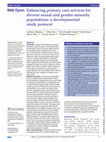
BMJ Open
IntroductionCompared with heterosexual, cisgender populations, sexual and gender minority (SGM) p... more IntroductionCompared with heterosexual, cisgender populations, sexual and gender minority (SGM) people are more likely to suffer from serious health conditions and insufficient access to health services. Primary care is at the frontlines of healthcare delivery; yet, few clinics have resources or mechanisms in place to meet SGM patient needs. This developmental study protocol focuses on reducing health disparities among SGM patients by identifying, adapting and developing SGM practice guidelines/recommendations and implementation strategies for primary care clinics in urban and rural New Mexico. Using input from patients, healthcare advocates and providers, and researchers, the study will pilot a practice parameter and implementation toolkit to promote SGM-specific cultural competence at multiple service delivery levels.Methods and analysisWe will recruit providers/staff from four Federally Qualified Health Centers (FQHCs) serving ethnically and geographically diverse communities. In...
Journal of Adolescent Health
Human Service Organizations: Management, Leadership & Governance
The managers of community-based organizations that are contracted to deliver publicly funded prog... more The managers of community-based organizations that are contracted to deliver publicly funded programs, such as in the child welfare sector, occupy a crucial role in the implementation and sustainment of evidence-based interventions to improve the effectiveness of services, as they exert influence across levels of stakeholders in multitiered systems. This study utilized qualitative interviews to examine the perspectives and experiences of managers in implementing SafeCare®, an evidence-based intervention to reduce child maltreatment. Factors influencing managers' abilities to support SafeCare® included policy and ideological trends, characteristics of leadership in systems and organizations, public-private partnerships, procurement and contracting, collaboration and coopetition, and support for organizational staff.

The Journal of School Nursing
Recruiting schools for intervention research can be daunting. This study examined the experiences... more Recruiting schools for intervention research can be daunting. This study examined the experiences of researchers recruiting public high schools for a randomized controlled trial to reduce suicide disparities for sexual and gender minority (SGM) youth by implementing evidence-based strategies to enhance school environments. We enrolled 42 schools throughout New Mexico between August 2016 and April 2017. Based on qualitative analysis of recruitment efforts, three groups of factors affected enrollment: (1) non-SGM-specific factors, (2) SGM-specific factors, and (3) facilitating factors. Non-SGM-specific factors negatively impacted the willingness or ability to participate (e.g., demanding staff workloads and beliefs that “outsiders” should not assist with school-based interventions). Notable SGM-specific factors centered on influences in socially conservative community environments and beliefs that schools lacked SGM students. Advocacy, leveraging relationships, and persistence were fa...

Social Science & Medicine
In this formative qualitative research, we draw upon the concepts of structural vulnerability and... more In this formative qualitative research, we draw upon the concepts of structural vulnerability and structural competency to examine how transgender and gender non-conforming (TGGNC) patients and healthcare personnel experience service delivery in Emergency Departments (EDs), and how this experience can be improved upon. Between October 2016 and June 2017, we undertook 31 semi-structured interviews with TGGNC patients (n = 11) and physicians (n = 6), nurses (n = 7), and non-clinical staff (n = 7) in four community-based EDs in New Mexico. Our iterative coding and analysis process resulted in eight sets of findings: (1) reasons why TGGNC patients seek care from EDs; (2) perceptions about and experiences of TGGNC patients; (3) relevance of gender identity and sex at birth; (4) bureaucracy and communication; (5) spatial considerations; (6) preparing providers and staff to care for TGGNC patients; (7) the lack of resources for structural prescriptions; and (8) respect, humanity, and sameness. Findings suggest that structural issues adversely impact the health and wellbeing of TGGNC patients and service-delivery practices in the ED. We describe study implications for training ED personnel and modifying this practice setting to prevent delayed care and ensure appropriate services for TGGNC patients in need of structurally competent emergency medicine.

The Journal of Behavioral Health Services & Research
Implementation and sustainment of evidence-based interventions (EBIs) is influenced by outer (e.g... more Implementation and sustainment of evidence-based interventions (EBIs) is influenced by outer (e.g., broader environments in which organizations operate) and inner (e.g., organizations, their administrators, and staff) contexts. One important outer-context element that shapes the inner context is funding, which is complex and unpredictable. There is a dearth of knowledge on how funding arrangements affect sustainment of EBIs in human service systems and the organizations delivering them, including child welfare and behavioral health agencies. This study uses qualitative interview and focus group data with stakeholders at the system, organizational, and provider levels from 11 human service systems in two states to examine how stakeholders strategically negotiate diverse and shifting funding arrangements over time. Study findings indicate that, while diverse funding streams may contribute to flexibility of organizations and possible transformations in the human service delivery environment, a dedicated funding source for EBIs is crucial to their successful implementation and sustainment.

Journal of Adolescent Health
The Centers for Disease Control and Prevention recommends six evidence-based strategies to improv... more The Centers for Disease Control and Prevention recommends six evidence-based strategies to improve safety and support for sexual and gender minority (SGM) youth in U.S. schools. However, only a small minority of schools implement all strategies. This study draws on implementation science to assess contextual challenges to strategy implementation. Semistructured interviews were conducted with at least two stakeholders at each of 42 high schools in New Mexico. Interviews consisted of open-ended questions centered on attitudes toward, access to, and availability of school and community supports for SGM youth, school policies, and practices, and organizational factors believed to impact implementation. Transcripts were imported into NVivo 11 for iterative coding and qualitative analysis. We identified eleven overarching sets of factors related to the preparedness of schools to implement the evidence-based strategies: (1) political climate; (2) community context; (3) community resources; (4) policies and practices; (5) staff knowledge and exposure to SGM issues; (6) training deficits; (7) prevalence of neutrality discourses suggesting SGM students should not be singled out for "special treatment" or intervention; (8) student attitudes and support; (9) de facto safe spaces; (10) health education curricula; and (11) pragmatic considerations, such as time, staff turnover, and workloads. Key factors believed to hinder implementation included lack of resources, staffing concerns, and knowledge deficits. These results can be used to inform the development of implementation strategies to modify school health systems from within to best support evidence-based practices for SGM youth and other stigmatized populations.
Uploads
Papers by Cathleen Willging